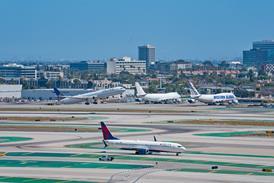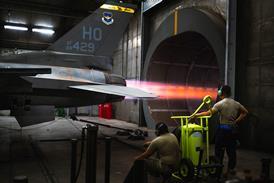The drive to cut costs on the Boeing 717 has given birth to a new concept in aircraft manufacturing - the moving production line
Guy Norris/LONG BEACH, CALIFORNIA
The adage "necessity is the mother of invention" has never been more appropriate than when it comes to Boeing's creation of the moving 717 production line at Long Beach, California.
The birth of this concept, unique to commercial aviation, goes back to the dark months just after Boeing's 1997 takeover of McDonnell Douglas when the newly named 717 - formerly the MD-95 - teetered on the edge of extinction. Survival depended on two developments: new sales and massive manufacturing cost-cutting unparalleled in the history of the industry.
The low-margin territory of the 100-seater range meant that sales and cost-cutting targets were virtually one and the same. To get to anything like the bargain-basement prices demanded by the airlines, Boeing had to bring about a step change in production costs - a task complicated by the large supplier involvement in the programme. In all, an estimated 72% of the unit cost of each 717 is outside the walls of the Long Beach plant.
The 717 team pledged to cut production costs by 10% by line number 100, 20% by line number 200 and 30% by number 300. These targets required every trick in the lean manufacturing handbook, plus the creation of a few new ones. Working in conjunction with the 'lean' gurus of Seattle and elsewhere in the extended Boeing empire, the 717 team took the first bold steps towards what would transform into the moving line on 19 April, 1998, when it changed to a single-piece flow production method.
This involved simplifying the line, re-arranging production into a more straightforward sequence, and choreographing the complex matrix of support processes - such as parts receiving, inventory, engineering and parts fabrication - into a more logical layout. The task of starting over with a clean-sheet assembly plan was daunting, but closing the MD-80/90 line had freed space in Building 80, the home of the 717.
Single flow line
The once familiar scene of Douglas T-tails marching down the length of Building 80 in their traditional 'slant' positions disappeared. In its place, 717s now stood nose-to-tail, moving towards the hangar door in a neat, single-flow line. This began with two parallel fuselage-to-wing join positions which fed the single line. Aircraft sat on their own gear almost immediately, and were pulled along by tugs from one work position to the next down the assembly line.
"The idea of the moving line came out of that, and it was a year after the single-piece flow move that we decided to go through with the moving line," says 717 programme lean enterprise group senior manager Rita Camarillo. The decision was not taken lightly, she recalls, adding: "It was a pretty big step to take."
To get there, Boeing has adopted a nine-point tactics plan, and a three-phase implementation strategy - both of which will come to fruition this year. The two processes are symbiotic, though the tactics plan works in parallel while the implementation process works in series. "We broke the whole effort into tactics, rather like sub-tiers. We didn't like using 'steps' because this led to the thought that one part might come before the other," says Camarillo.
Tactics and strategy
Tactic 1 is called value stream mapping, and is about defining the assembly process and its supporting infrastructure. The basic idea, says 717 programme operations and quality director Bob Stanger, is to establish "how best to apply resources and focus lean where it will provide the most benefit". By mapping the current state of the line and its flow times, queue times and work-in-process inventory, the team was able to gauge what needed to be done, and where. Tactic 2 is about 'balancing the line', or evenly distributing work across the assembly span with job assignments based on 'takt' time. The 'takt' concept, originating from a Swedish word and adapted for Japanese car assembly lines, revolves around constant attention to the clock and alignment of the line's "heart beat" against this time. "We assign work in the best way across all three shifts and it helps us manage the assets better too," says Stanger. Tactic 3 is called standard work, and hinges on studying the sequence of assembly work and identifying actions that waste time and effort. "By doing this, we can put a template against each job so there is a standard expectation and it keeps employees directly involved," Stanger says. "We're not yet at the point where all the employees are tied in, but we have been teaching influential people about lean and they come out on the line as 'disciples','' he adds. Tactic 4 is visual controls, and is a key benefit of the moving line process. Two main types of visual systems have been introduced: progress indicators and problem indicators. Progress indicators are generally large production-scheduling scoreboards that any employee can use to see when production is ahead, behind or on schedule. Process indicators are traffic-light type signals that illuminate to show the status of a machine or process. Green lights are good, yellow calls for attention and red is bad. Tactic 5 is called point of use, and is perhaps the most obvious improvement brought about by lean as far as the average line worker is concerned. This ensures everyone has the right information, parts, tools and equipment where and when they need them. Parts and tools for certain jobs, for example, are 'kitted' in special plastic-wrapped boxes resembling model aircraft parts. The kits were designed by the line workers, who are now described as "surgeons" looking after their "patients" - the aircraft. Tactic 6 covers establishing feeder lines, and involves re-packaging some assembly work in a different order. For example, inboard and outboard flaps will be attached to wings before - rather than after - joining to the fuselage. This means the completed wings arrive on the line when they are required, freeing assembly floor area, reducing lead time and improving quality, says Stanger. This process also heavily involves suppliers, which have mirrored the changes at Long Beach in many cases, to suit the modifications on their own lines. "Honeywell came here and are now supplying boxes when we need them, which saves huge inventory costs," adds Camarillo.Employee-driven changes
Tactic 7 is chiefly concerned with employee-driven changes to the design of parts, tools and support processes to cut time, defects and inventory and is "a common sense way of doing things", says Aaron Kotyluk, moving line flow production engineer. The flightdeck glareshield, for example, once made from 20 parts, is now a more easily installed one-piece unit. Tactic 8 is the move to the pulse line, the biggest step on the way to a moving line, which was accomplished in November 2000. The line currently moves en masse, once every six days, at the push of a button. Each aircraft is mounted on an elevated cradle attached to an under-floor chain, and moves 43m (141ft) at the rate of 3m/min. The move takes 20 minutes compared with the entire third shift (around seven hours) taken previously. Two electrically driven chains, weighing almost 30,000kg and 670m long, move in Teflon-coated channels 1m below ground level. The pulse line is the second part of the three-phase transition, the first being the move to the single-piece flow, and the last, set for this August, is the move to the moving line. This is enshrined in Tactic 9, and is modelled on lines such as GM's Saturn car factory in Tennessee which was "benchmarked" by Boeing for the 717. The plan is for the line to move continuously, though not at weekends, at around 20mm/min and to only stop when a problem crops up. Paradoxically, Kotyluk says "the production line is moving so you can stop it. You stop it so you can solve the problem. The great thing about a moving line is it brings the rocks to the surface and shows us immediately where the problems are." Stanger adds: "It ends up being a draw for everything we do from the way we manage assets to the way we build, and even to the way our suppliers do business."Although American's planned purchase of a big 717 customer, Trans World Airlines, caused Boeing to back away from its projected target of 60 aircraft in 2001, the moving line plan is expected to dramatically increase both the flexibility and productivity of the line while cutting assembly time by 50% compared to the MD-80. While necessity may lay at its roots, Boeing hopes the outcome will be the 'mother' of all assembly lines.
Source: Flight International























